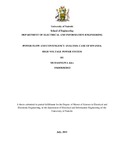| dc.description.abstract | This thesis uses power flow and contingency analysis to investigate operating conditions of Rwanda High Voltage Power System and evaluate the impact of branch outage on its operational status. We utilize contingency analysis and performance indices to assess if the system can withstand the impact of transmission outage in relation to available load demand and load demand increase scenarios.
AC load flow method by Newton Raphson algorithm in MATLAB environment are used to determine voltage magnitude and phase angle of each busbar in the system, real and reactive power flowing on the network branches. They are also applied to reveal line outage impacts on the transmission lines transfer capacity in terms of thermal rating, buses prescribed voltage margins and rank their severity influence on the remaining system elements. It is known that element outage in the power system is caused by loadability in the network, specific technical and operational failure of the system elements including scheduled maintenance for a particular part of the system. This is done and attained by the power system operators on the power dispatcing centres by the use of on-line analysis of supervisory control and data acquisition (SCADA). They eventually detect and control system hazards to provide defensive measures for reliable service. However, in this research we adhere to offline study to classify sabotages by referring to the buses accepted voltage margins and thermal ratings in the system branches. In doing so, we rank sequentially the highest value of Performance Index(PI) as the first critical sabotage and lowest value as the minor hazard subjected to the network. This informs the system planner which system transmission lines can be put in the first phase of transmission lines expansion. Therefore, it provides the overriding pathway to maintain power system security in order to have the expectable reliability in the power network. | en_US |

